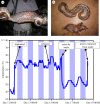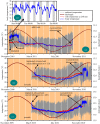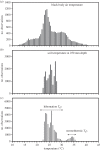Mammal survival at the Cretaceous-Palaeogene boundary: metabolic homeostasis in prolonged tropical hibernation in tenrecs
- PMID: 25339721
- PMCID: PMC4213634
- DOI: 10.1098/rspb.2014.1304
Mammal survival at the Cretaceous-Palaeogene boundary: metabolic homeostasis in prolonged tropical hibernation in tenrecs
Abstract
Free-ranging common tenrecs, Tenrec ecaudatus, from sub-tropical Madagascar, displayed long-term (nine months) hibernation which lacked any evidence of periodic interbout arousals (IBAs). IBAs are the dominant feature of the mammalian hibernation phenotype and are thought to periodically restore long-term ischaemia damage and/or metabolic imbalances (depletions and accumulations). However, the lack of IBAs in tenrecs suggests no such pathology at hibernation Tbs > 22°C. The long period of tropical hibernation that we report might explain how the ancestral placental mammal survived the global devastation that drove the dinosaurs and many other vertebrates to extinction at the Cretaceous-Palaeogene boundary following a meteorite impact. The genetics and biochemistry of IBAs are of immense interest to biomedical researchers and space exploration scientists, in the latter case, those envisioning a hibernating state in astronauts for deep space travel. Unravelling the physiological thresholds and temperature dependence of IBAs will provide new impetus to these research quests.
Keywords: Cretaceous–Palaeogene boundary; Madagascar; Tenrec ecaudatus; hibernation; mammals.
© 2014 The Author(s) Published by the Royal Society. All rights reserved.
Figures



Similar articles
-
Extreme physiological plasticity in a hibernating basoendothermic mammal, Tenrec ecaudatus.J Exp Biol. 2018 Oct 18;221(Pt 20):jeb185900. doi: 10.1242/jeb.185900. J Exp Biol. 2018. PMID: 30158129
-
Torpor and hibernation in a basal placental mammal, the Lesser Hedgehog Tenrec Echinops telfairi.J Comp Physiol B. 2008 Aug;178(6):691-8. doi: 10.1007/s00360-008-0257-9. Epub 2008 Mar 27. J Comp Physiol B. 2008. PMID: 18368412
-
Common tenrecs (Tenrec ecaudatus) reduce oxygen consumption in hypoxia and in hypercapnia without concordant changes to body temperature or heart rate.J Comp Physiol B. 2024 Dec;194(6):869-885. doi: 10.1007/s00360-024-01587-9. Epub 2024 Oct 7. J Comp Physiol B. 2024. PMID: 39373763
-
The role of energy availability in Mammalian hibernation: a cost-benefit approach.Physiol Biochem Zool. 2003 Mar-Apr;76(2):165-79. doi: 10.1086/367950. Physiol Biochem Zool. 2003. PMID: 12794670 Review.
-
Metabolic rate depression: the biochemistry of mammalian hibernation.Adv Clin Chem. 2010;52:77-108. Adv Clin Chem. 2010. PMID: 21275340 Review.
Cited by
-
Ambient Temperature Cycles Affect Daily Torpor and Hibernation Patterns in Malagasy Tenrecs.Front Physiol. 2020 May 28;11:522. doi: 10.3389/fphys.2020.00522. eCollection 2020. Front Physiol. 2020. PMID: 32547412 Free PMC article.
-
Hibernation in a primate: does sleep occur?R Soc Open Sci. 2016 Aug 10;3(8):160282. doi: 10.1098/rsos.160282. eCollection 2016 Aug. R Soc Open Sci. 2016. PMID: 27853604 Free PMC article.
-
Phoenix from the Ashes: Fire, Torpor, and the Evolution of Mammalian Endothermy.Front Physiol. 2017 Nov 2;8:842. doi: 10.3389/fphys.2017.00842. eCollection 2017. Front Physiol. 2017. PMID: 29163191 Free PMC article. No abstract available.
-
Flickering body temperature anticipates criticality in hibernation dynamics.R Soc Open Sci. 2021 Jan 13;8(1):201571. doi: 10.1098/rsos.201571. eCollection 2021 Jan. R Soc Open Sci. 2021. PMID: 33614089 Free PMC article.
-
Patterns and determinants of the global herbivorous mycobiome.Nat Commun. 2023 Jun 26;14(1):3798. doi: 10.1038/s41467-023-39508-z. Nat Commun. 2023. PMID: 37365172 Free PMC article.
References
-
- Hildebrand AR, Penfield GT, Kring DA, Pilkington M, Camargo A, Jacobsen SB, Boynton WV. 1991. Chicxulub Crater: a possible Cretaceous Tertiary boundary impact crater on the Yucatan Peninsula, Mexico. Geology 19, 867–871. (10.1130/0091-7613) - DOI
-
- Robertson DS, McKenna MC, Toon OB, Hope S, Lillegraven JA. 2004. Survival in the first hours of the Cenozoic. Geol. Soc. Am. Bull. 116, 760–768. (10.1130/b25402.1) - DOI
Publication types
MeSH terms
LinkOut - more resources
Full Text Sources
Other Literature Sources

